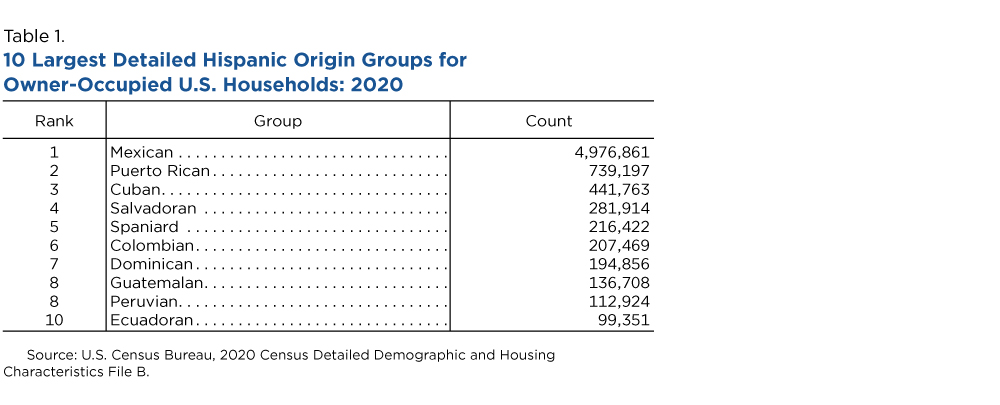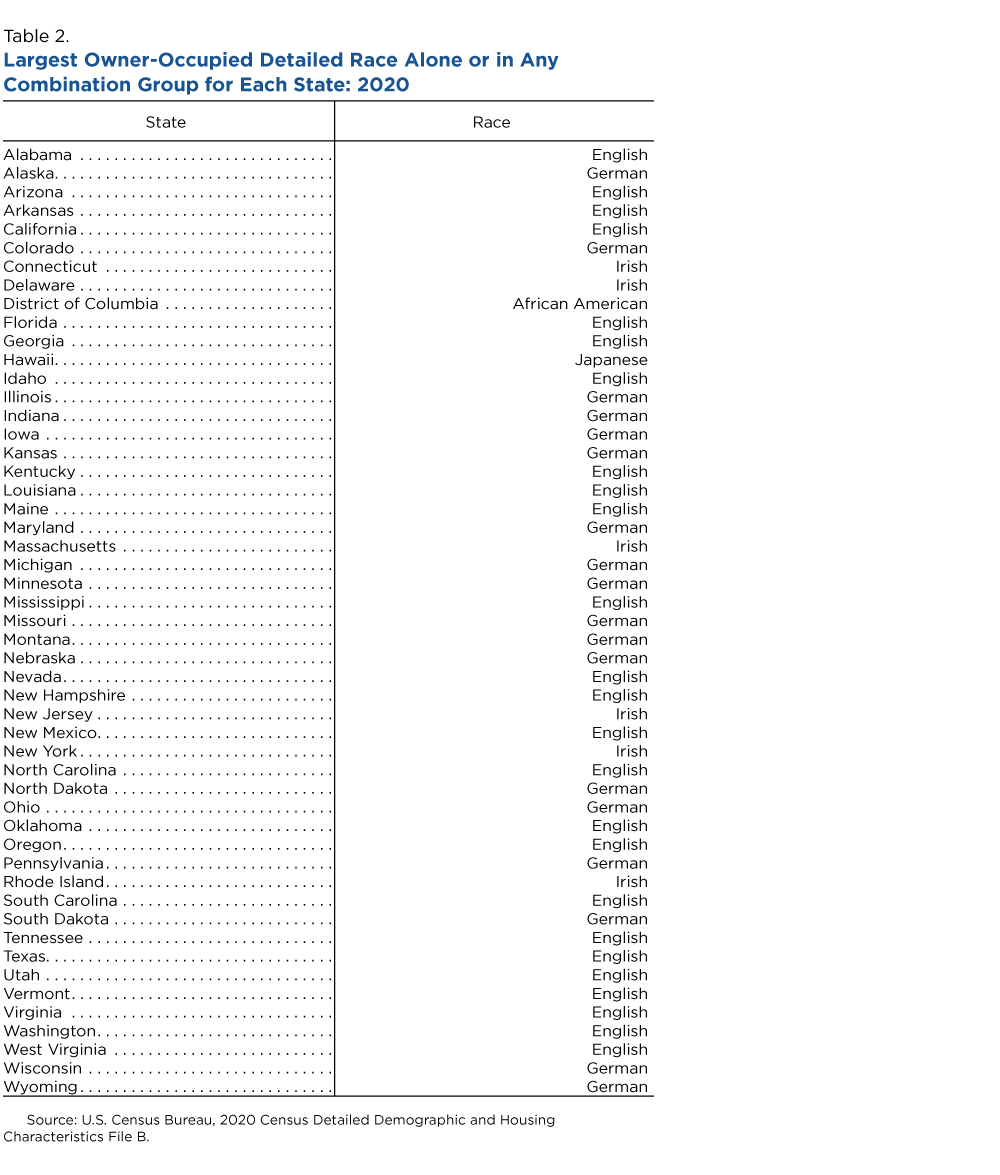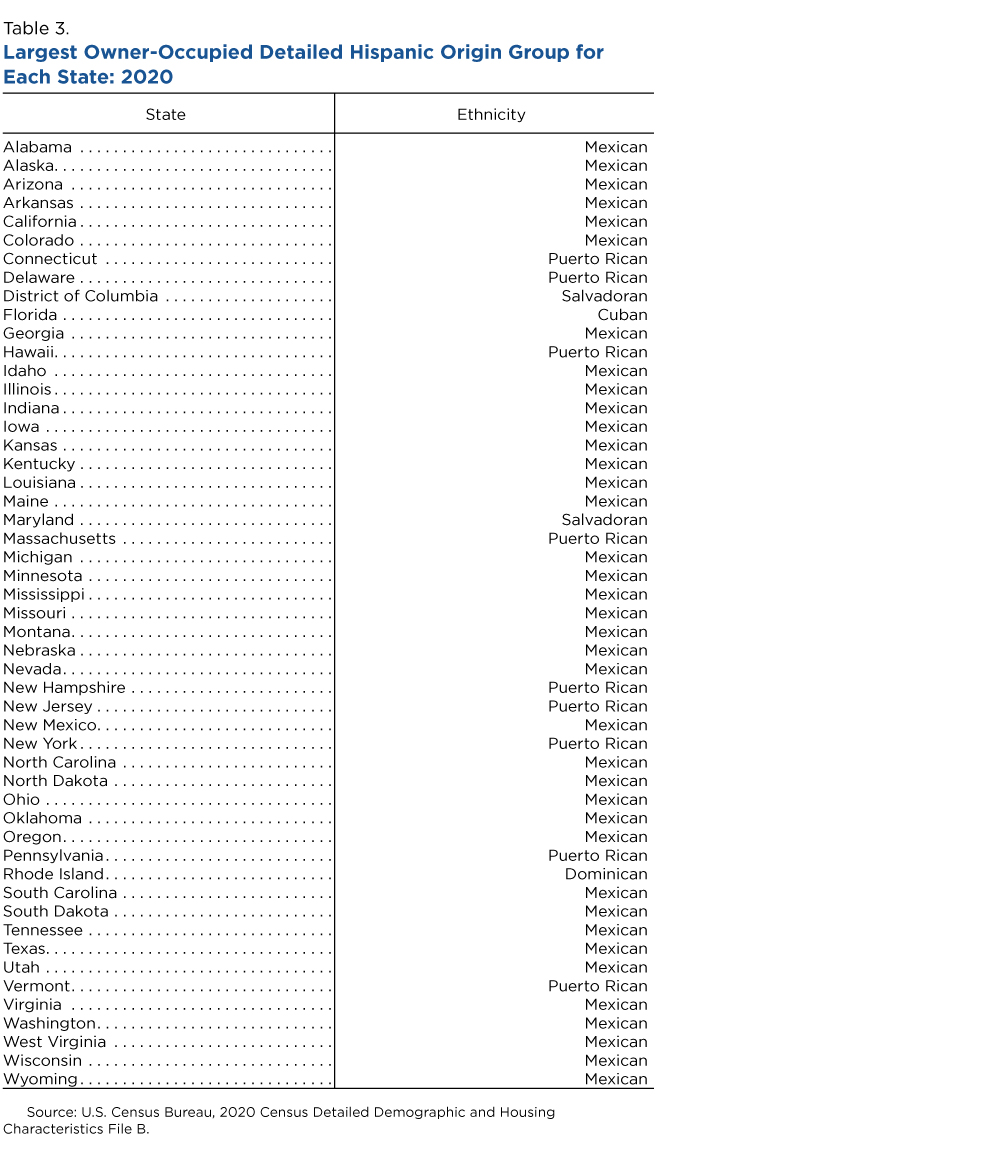Households That Reported Being English or German Topped List of Owner-Occupied U.S. Households
The largest number of U.S. householders who own the homes they live in identified as English, according to 2020 Census detailed race and ethnicity data released today.
The Detailed Demographic and Housing Characteristics File B shows whether a home is owned or rented and if family or nonfamily members live in it.
Data are available for approximately 1,500 detailed race and ethnicity groups and detailed American Indian and Alaska Native (AIAN) tribes and villages.
The race and ethnicity data for households reflect the response of the householder. For the 2020 Census, the householder is the first adult listed in the household’s census response.
In 2020, many states mirrored the national patterns: English alone or in any combination was the largest group of owner-occupied households in 25 states and German alone or in any combination was the largest in 18 states.
When a householder lives in a home they own, it is considered owner-occupied, whether mortgaged or not.
In this article, we present “race alone” and “race alone or in any combination” data created from the detailed responses to the 2020 Census race question.
The “race alone” population includes households where the householder reported only one race response, such as Irish. The “race alone or in any combination” population includes households where the householder gave one response like Irish, and households where the householder reported multiple responses like Irish and Italian or Irish and Samoan.
Only a single response was tabulated in response to the Hispanic origin question, following the Office of Management and Budget’s 1997 Revisions to the Standards for the Classification of Federal Data on Race and Ethnicity. (The updated standards will be implemented in future data collections.) Counts for detailed Hispanic origins groups, such as “Mexican,” reflect the householder’s response.
Owner-Occupied Households Nationally
An estimated 14.6 million householders reported being English alone or in any combination, making that the largest group of owner-occupied households at the national level in 2020. They were followed by German alone or in any combination (13.9 million) and Irish alone or in any combination (11.3 million).
Twenty-three other detailed alone or in any combination groups had over one million owner-occupied households, including African American (3.8 million), Scottish (2.6 million) and Chinese, except Taiwanese (1.1 million).
Owner-Occupied Households by State
In 2020, many states mirrored the national patterns: English alone or in any combination was the largest group of owner-occupied households in 25 states and German alone or in any combination was the largest in 18 states.
Although these two race groups were the largest, they were not necessarily the majority of homeowners in that state as there is great diversity in homeownership by race.
The following detailed race alone or in any combination groups comprised the largest number of owner-occupied households in the remaining states and the District of Columbia:
- Irish – Connecticut, Delaware, Massachusetts, New Jersey, New York, and Rhode Island.
- African American – the District of Columbia.
- Japanese – Hawaii.
The new data are critical in identifying changing trends in homeownership from 2010 to 2020 for the nation’s detailed race and ethnicity groups. For example, they show that home ownership among the Mexican population increased by 27.5% (from 3.90 million to 4.98 million) during the 10-year period.
While this article only covers the national and state data, this same information is available for smaller geographies like counties and census tracts or neighborhoods.
The data can supplement information already published by the American Community Survey in its Special Population Tables (SPT) and American Indian Alaskan Native Tables (AIANT) to gain a better understanding of the nation’s housing and households.
Subscribe
Our email newsletter is sent out on the day we publish a story. Get an alert directly in your inbox to read, share and blog about our newest stories.
Contact our Public Information Office for media inquiries or interviews.
-
HousingYounger Householders Drove Rebound in U.S. HomeownershipJuly 25, 2023Housing Vacancy Survey found homeownership rates, especially among those age 44 and younger, improved in all regions.
-
PopulationEnglish Most Common Race or Ethnicity in 2020 CensusOctober 10, 2023Recently released 2020 Census data on race and ethnicity provide detailed characteristics of more than 100 White groups.
-
PopulationDetailed Characteristics of Hundreds of Race/Ethnic and Tribal GroupsJune 15, 2023Detailed social, economic, housing and demographic characteristics on race, Hispanic origin, ancestry and tribal groups now available for numerous geographies.
-
NAICS Sector 31-33 ManufacturingSome Less Populous States Have High Manufacturing Revenue Per CapitaSeptember 29, 2025Today is the start of a week of celebrations at the Census Bureau marking the 14th annual Manufacturing Day on October 3.
-
Families and Living ArrangementsCouples’ Finances: Married but SeparateSeptember 24, 2025While most married couples had joint bank accounts, fewer shared all their financial accounts.
-
FertilityChildlessness on the Rise — Except for Women Ages 45 to 50September 23, 2025From 2014 to 2024, the share of older mothers rose as fewer teens and women in their 20s and 30s had children.
-
Business and EconomyHow AI and Other Technology Impacted Businesses and WorkersSeptember 17, 2025Businesses report that, in most cases, adoption of new technologies like robotics and Artificial Intelligence had no impact on worker numbers or skill level.








